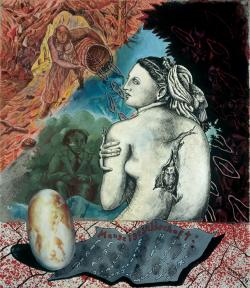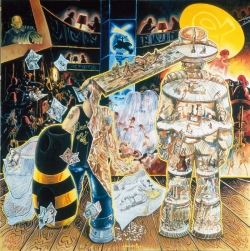IMM.0001.jpg)
IMM.00041.jpg)

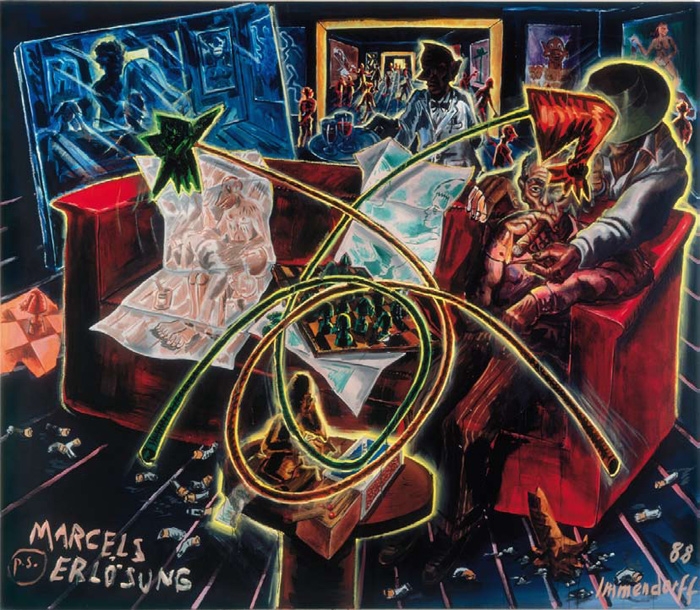
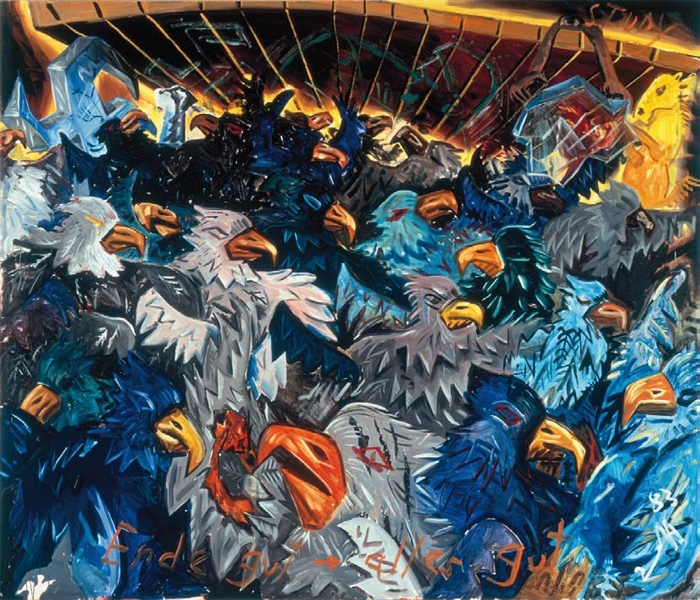
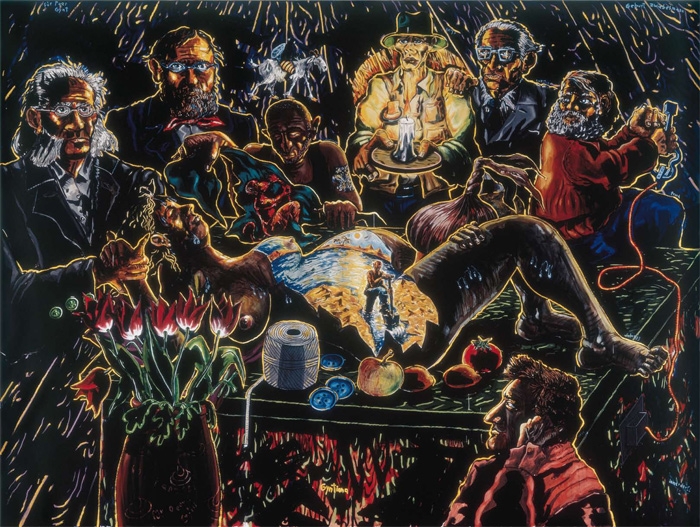

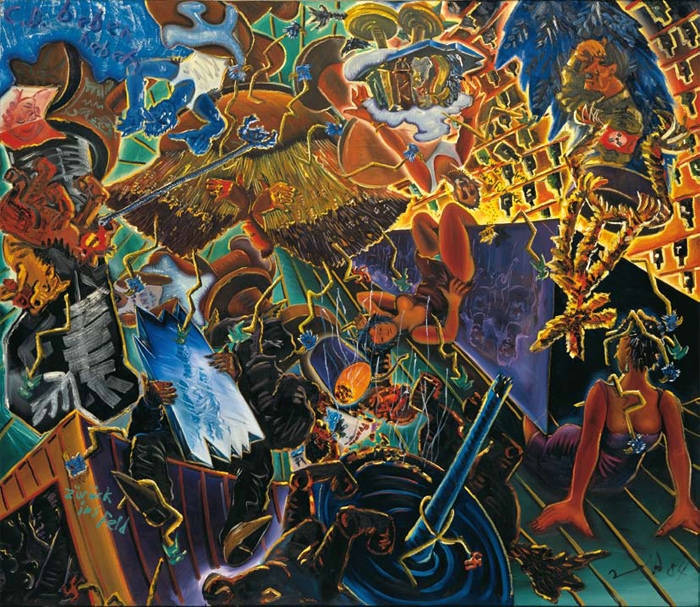
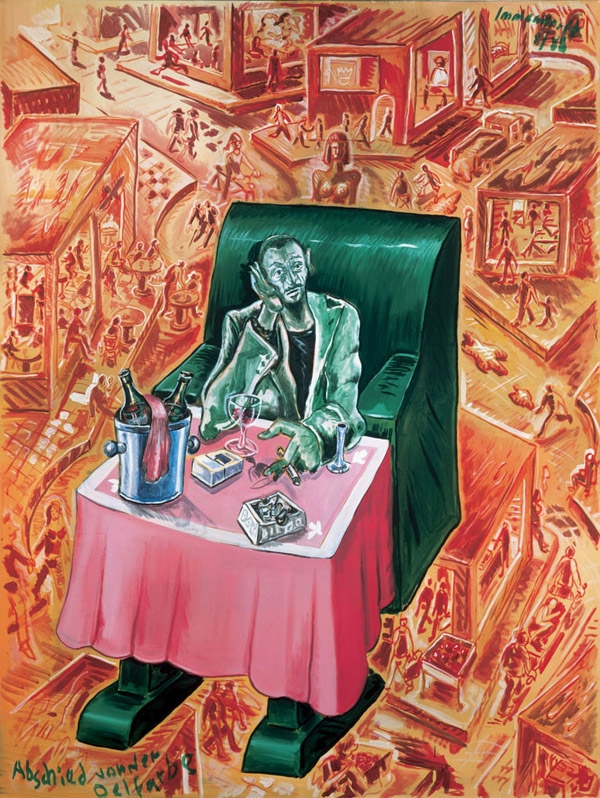
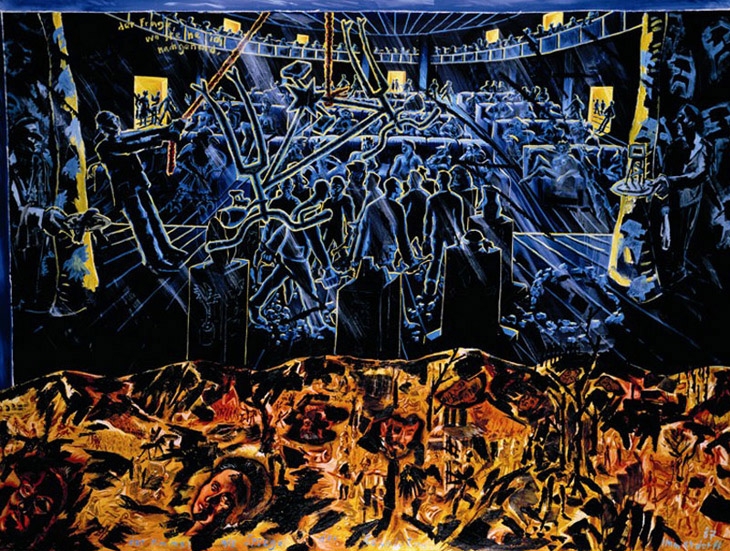
ARTIST:
Jörg Immendorff
Adapting all the elements of a nineteenth century allegory, Jorg Immendorff’s Back to Front is a political manifesto rendered through symbolism.
Jorg Immendorff presents a canvas divided in three parts: labour, knowledge and possibility. His central figure, a goddess-like woman embodying an owl of wisdom, is the icon nurture and virtue, radiant against the bleak background of storm clouds and darkness. Through her flows a stream of fertility and rebirth in the form of labia-like fruits, proffered from the toil of the rural worker.
In the foreground, Jorg Immendorff depicts the present as an arid and cracked soil. His egg - reminiscent of the globe - offers hope for the future, weighting down a manuscript stating: ‘Society with a lack: industry, pride, honesty, respect before Art.’ Spanning three decades of immense political change in his native Germany, Jorg Immendorff’s work took a turn from the political to the personal in the late eighties. His many self-portraits depict a lonely creator, whose role as cultural antenna has been rendered suddenly obsolete.
Society of Deficiency is a more gloomy scene: the artist in his studio/toxic wasteland, struggling to create, surrounded by repetitive symbols of Joseph Beuys’ hat and a primitive monument of himself. In an ode to Dadaist icon Marcel Duchamp, Jorg Immendorff paints an art hero’s Valhalla. In a living-room-cum-art studio-cum-club, he gives the illusion of theatrical space. Images within images, he builds an architecture through the placement of paintings throughout the room, confusing masterpiece with reality.
Towards the back of the scene lies a brighter framed image: this is no ordinary lounge, but a private celebrity chamber of Café Deutschland. Figured with his favourite cigars and chessboard, and tuxedoed waiter bringing tipple, Duchamp accepts a light from the always hatted Joseph Beuys.
Seeming to wallow in his own chain-smoking reclusiveness, Jorg Immendorff renders Duchamp as a rat-packish figure from another era. High class tinged with sadness, he cuts through with an energetic doodle of slapstick zaniness. In this painting, Jorg Immendorff presents a divided Germany in turmoil. Adopting Shakespeare’s theatre as a post-Fascist arena, eagle-folk run en masse towards the future, while the few still clamouring to the past are trampled, bleeding, underfoot. In Gyntiana, Jorg Immendorff presents an allegory of creation: surrounded by heroes of ideological importance, an onion springs forth from a richly fertile womb. Jorg Immendorff once said that painting ‘has the function of a potato’. Here it’s reborn in the multilayered richness of ideological and intellectual nourishment. In later paintings Jorg Immendorff turns his concerns to the politics of the art world, drawing reference from and adding to a critical lexicon of art history. In Door to the Sun, his theatre is seen from backstage. The haloed silhouette of his mentor Beuys, dominating the arena, is rendered as a Wizard of Oz construction: not a man, but a museum, being slowly uncrated into the form of Jorg Immendorff. His ice forms, which previously symbolised the freezing decay of a nation, now embody the tools of painting. Jörg Immendorff’s large canvases are often fraught with the imagery of a literal theatre of decadence. His stage-set compositions allude to the illusionary aspects of art, presenting a script of personal mythology that is often poignant, humorous, scathing and prophetic.
Myth-making is at the core of Jorg Immendorff’s work. Political iconography, such as the German eagle, Soviet sickle and Socialist Worker’s fist, mix quite literally with his ever expanding cast of characters, including both politicians and artist friends. At the heart is a rewriting of history - both political and artistic - where personal positioning and moral reconciliation are at the forefront.
Jorg Immendorff presents a canvas divided in three parts: labour, knowledge and possibility. His central figure, a goddess-like woman embodying an owl of wisdom, is the icon nurture and virtue, radiant against the bleak background of storm clouds and darkness. Through her flows a stream of fertility and rebirth in the form of labia-like fruits, proffered from the toil of the rural worker.
In the foreground, Jorg Immendorff depicts the present as an arid and cracked soil. His egg - reminiscent of the globe - offers hope for the future, weighting down a manuscript stating: ‘Society with a lack: industry, pride, honesty, respect before Art.’ Spanning three decades of immense political change in his native Germany, Jorg Immendorff’s work took a turn from the political to the personal in the late eighties. His many self-portraits depict a lonely creator, whose role as cultural antenna has been rendered suddenly obsolete.
Society of Deficiency is a more gloomy scene: the artist in his studio/toxic wasteland, struggling to create, surrounded by repetitive symbols of Joseph Beuys’ hat and a primitive monument of himself. In an ode to Dadaist icon Marcel Duchamp, Jorg Immendorff paints an art hero’s Valhalla. In a living-room-cum-art studio-cum-club, he gives the illusion of theatrical space. Images within images, he builds an architecture through the placement of paintings throughout the room, confusing masterpiece with reality.
Towards the back of the scene lies a brighter framed image: this is no ordinary lounge, but a private celebrity chamber of Café Deutschland. Figured with his favourite cigars and chessboard, and tuxedoed waiter bringing tipple, Duchamp accepts a light from the always hatted Joseph Beuys.
Seeming to wallow in his own chain-smoking reclusiveness, Jorg Immendorff renders Duchamp as a rat-packish figure from another era. High class tinged with sadness, he cuts through with an energetic doodle of slapstick zaniness. In this painting, Jorg Immendorff presents a divided Germany in turmoil. Adopting Shakespeare’s theatre as a post-Fascist arena, eagle-folk run en masse towards the future, while the few still clamouring to the past are trampled, bleeding, underfoot. In Gyntiana, Jorg Immendorff presents an allegory of creation: surrounded by heroes of ideological importance, an onion springs forth from a richly fertile womb. Jorg Immendorff once said that painting ‘has the function of a potato’. Here it’s reborn in the multilayered richness of ideological and intellectual nourishment. In later paintings Jorg Immendorff turns his concerns to the politics of the art world, drawing reference from and adding to a critical lexicon of art history. In Door to the Sun, his theatre is seen from backstage. The haloed silhouette of his mentor Beuys, dominating the arena, is rendered as a Wizard of Oz construction: not a man, but a museum, being slowly uncrated into the form of Jorg Immendorff. His ice forms, which previously symbolised the freezing decay of a nation, now embody the tools of painting. Jörg Immendorff’s large canvases are often fraught with the imagery of a literal theatre of decadence. His stage-set compositions allude to the illusionary aspects of art, presenting a script of personal mythology that is often poignant, humorous, scathing and prophetic.
Myth-making is at the core of Jorg Immendorff’s work. Political iconography, such as the German eagle, Soviet sickle and Socialist Worker’s fist, mix quite literally with his ever expanding cast of characters, including both politicians and artist friends. At the heart is a rewriting of history - both political and artistic - where personal positioning and moral reconciliation are at the forefront.
IMM.0001.jpg)
IMM.00041.jpg)
